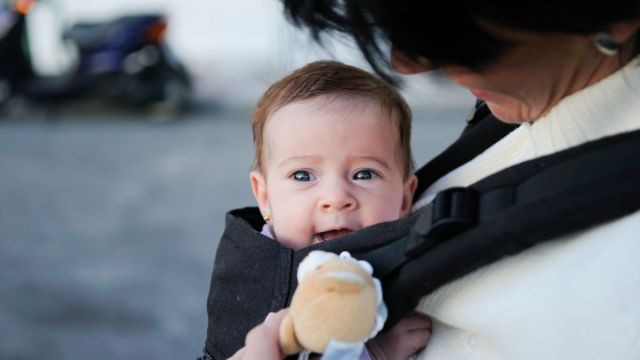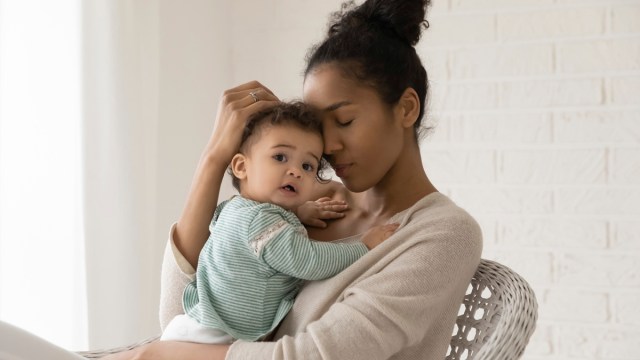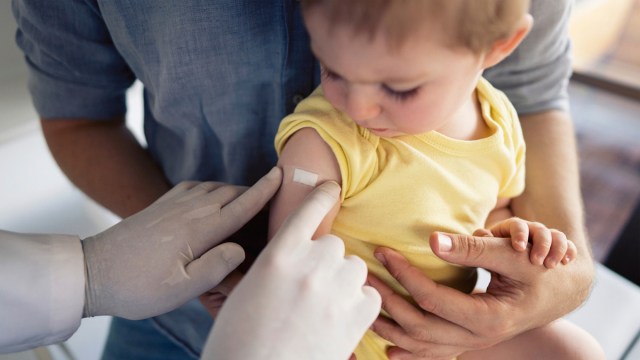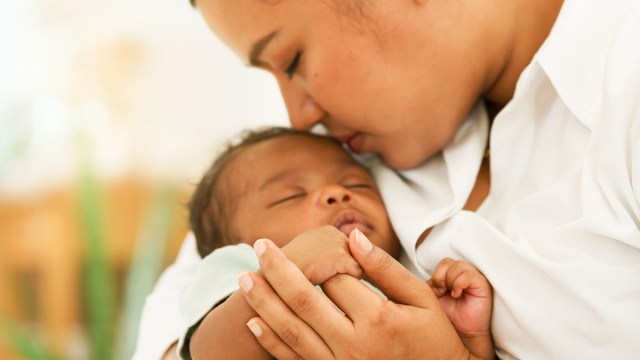A few weeks ago, my one-year-old and I flew to visit family out of state. The trip there was relatively smooth, save for a tricky leaky diaper situation, but a couple of days into our stay my throat started to feel like it was lined with sandpaper and I knew that my first cold of the season was officially here. There’s never a “good” time to have a cold, but I hated the prospect of a rockier return flight if my daughter caught it and had to suffer through congestion and painful ear pressure on the plane. As a nurse, I went into germ-prevention mode to avoid getting her sick—and with a lot of diligence (and a little luck), it worked! (As a reward, she treated me to an uneventful ride home.)
Since newborn immune systems aren’t completely mature, they’re especially vulnerable to becoming very ill with viruses that are annoying but otherwise harmless in older kids and adults. When it comes to keeping babies safe from the season’s nastiest respiratory viruses, the good news is you probably already learned some of the key advice when you brought yours home from the hospital: Wash your hands often, pop a bottle of hand sanitizer by the door for visitors, and don’t let anyone who’s ill hang with your baby. But what if you’re the one who’s sick and you still have to take care of them?
As a nurse and mom, I’ve seen how taking a few extra proactive steps can protect your little ones from colds and other respiratory viruses like RSV, COVID-19, and the flu, even as they age out of the danger zone. Whether the germs are inside or outside your house, here are some of the most common viruses and what I recommend to keep them at bay.

Which respiratory viruses are most common in babies?
Respiratory viruses are spread by droplets that are released into the air when a sick person coughs or sneezes. We become sick when the virus enters our respiratory tract through either direct person-to-person contact, by breathing in infected droplets, or by touching a contaminated object and then touching the mucous membranes on our face such as our eyes, nose, and mouth.
Common Cold
Many cases of the common cold result from a rhinovirus infection. For babies, the symptoms of a cold and those of more serious illnesses can look the same at first. If your baby is less than 3 months old, cold symptoms or a fever of 100.4 degrees Fahrenheit or higher warrants an immediate call to the pediatrician.
What to look for: Stuffy or runny nose, unusually fussy, fever.
COVID-19
COVID-19 spreads much more easily than other respiratory viruses like the cold or the flu. In addition to coughs or sneezes, respiratory droplets can also spread from talking or singing. While kids aren’t as likely as adults to become very ill with COVID-19, some do end up in the hospital with respiratory support from a ventilator.
What to look for: Fever, cough, extreme tiredness, nausea, diarrhea.
RSV
RSV stands for respiratory syncytial virus and is especially dangerous if your baby is less than 6 months old. This is because if they catch it, their first symptom may be apnea, which means they take long pauses in breathing, causing their oxygen level to drop. Babies with RSV are often hospitalized because they require medical care and oxygen support until the infection resolves.
What to look for: Apnea, runny nose, cough, and sometimes a fever.
Flu
The flu is caused by influenza viruses and, as with RSV, your newborn can become much sicker than if you or an older kid were to catch it. The flu increases newborns’ risk of developing more serious respiratory complications such as pneumonia or apnea.
What to look for: Cold symptoms like cough, fever, and runny or stuffy nose. Can also include sleepiness, vomiting, diarrhea, fussiness, and trouble consoling baby.
Remember, you are the expert on your baby’s behavior and disposition. With any illness, if you feel that something isn’t right, don’t hesitate to contact your healthcare provider for guidance. Symptoms that require immediate medical attention include breathing much faster than usual, retractions (the muscles around their ribs pull in with each breath), wheezing, or lips or skin that is a bluish color.

Tips for preventing the spread of respiratory viruses:
As your child gets older, getting sick becomes inevitable—especially when they start daycare. But if your baby is brand new, or you just want to try to limit how much your family is home sick this flu season, here are some things you can do to keep respiratory viruses at bay.
1. Practice a handwashing technique that gets the job done every time.
I like to think about giving my baby a bath when I’m washing my hands. If I simply dipped her in the tub, dabbed on some soap, and then rinsed her off, she’d still be kinda dirty. To effectively reduce the spread of germs, you’ll want to work up a good sudsy lather. Soap contains ingredients that lift dirt and disease-causing germs from your skin. These unwelcomed guests are then rinsed down the drain. Your goal is to create friction as you carefully clean all parts of your hands while singing “Happy Birthday” twice to yourself. This gives you the recommended time (20 seconds) to get your hands adequately clean. After a good rinse, be sure to dry your hands well because germs are transferred more easily if they are still damp.
Related: Nurse Shares 3 Signs That Your Sick Kid Needs to Go to the ER
If soap and water aren’t handy, using hand sanitizer with at least 60% alcohol can help prevent the spread of certain germs. Use enough to wet all surfaces of your hands and rub them together, again for 20 seconds, until they are dry. Good hand hygiene at the right time is crucial to preventing the spread of germs, especially after touching public surfaces or blowing your nose if you’re the one who’s ill. Make sure your hands are clean before touching your baby’s face around their eyes, nose, or mouth. Remember, respiratory viruses love those mucous membranes.
2. Stop the droplets however you can.
Avoiding sick people is a good idea in general, and if you’re the one who’s coughing and sneezing, you can reduce the spread of germs by containing your respiratory droplets with a tissue or the inside of your elbow. But let’s be honest: when you’re caring for an infant, you don’t always have a tissue or a free elbow. As a nurse working in the hospital pre-COVID-19 times, if you had the sniffles but were otherwise healthy enough to report to work, the expectation was to wear a mask when doing direct patient care. I did this with my recent cold to keep virus-containing droplets from landing on my baby while I was holding and feeding her. If another member of your household is sick, having them wear a mask at home can help protect your baby and others in your family, particularly if they are coughing and sneezing. With sick siblings, this can be a tall order, but do your best to encourage them to cover their mouths.

3. Take advantage of current vaccinations.
Unfortunately, there isn’t an effective vaccine against the common cold because there are over 100 different kinds of rhinoviruses and each one is constantly changing. But for other respiratory viruses like COVID-19, RSV, and influenza, there are vaccines available that are a great way to reduce the spread and protect those who have a higher risk of becoming severely ill. Mothers who have immunity against these illnesses, either from receiving vaccines or from actually getting sick during pregnancy, provide passive immunity to their newborns through the placenta or breastmilk. However, this passive immunity is temporary and protection decreases after a few weeks or months. Chat with your pediatrician to better understand the benefits and risks of each vaccine and recommendations for when you and your baby should get them.
Yes, navigating the real world while shielding your baby from so many seasonal viruses can be tricky. But when used in combination, these three strategies provide a powerful defense. Whether you’re at the pediatrician’s office for your newborn’s well-baby check-up, introducing your new arrival to family and friends, or traveling with your toddler, remember how respiratory viruses spread and practice these habits to lower the likelihood of your little one getting sick.











